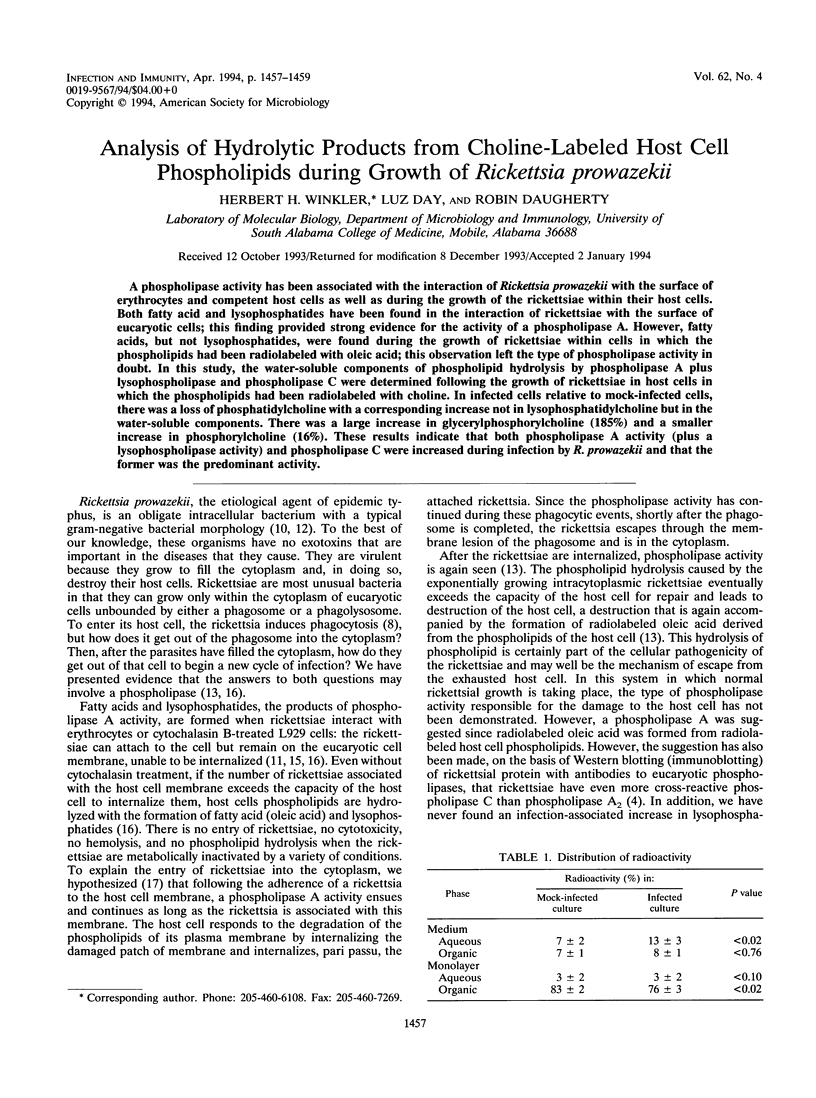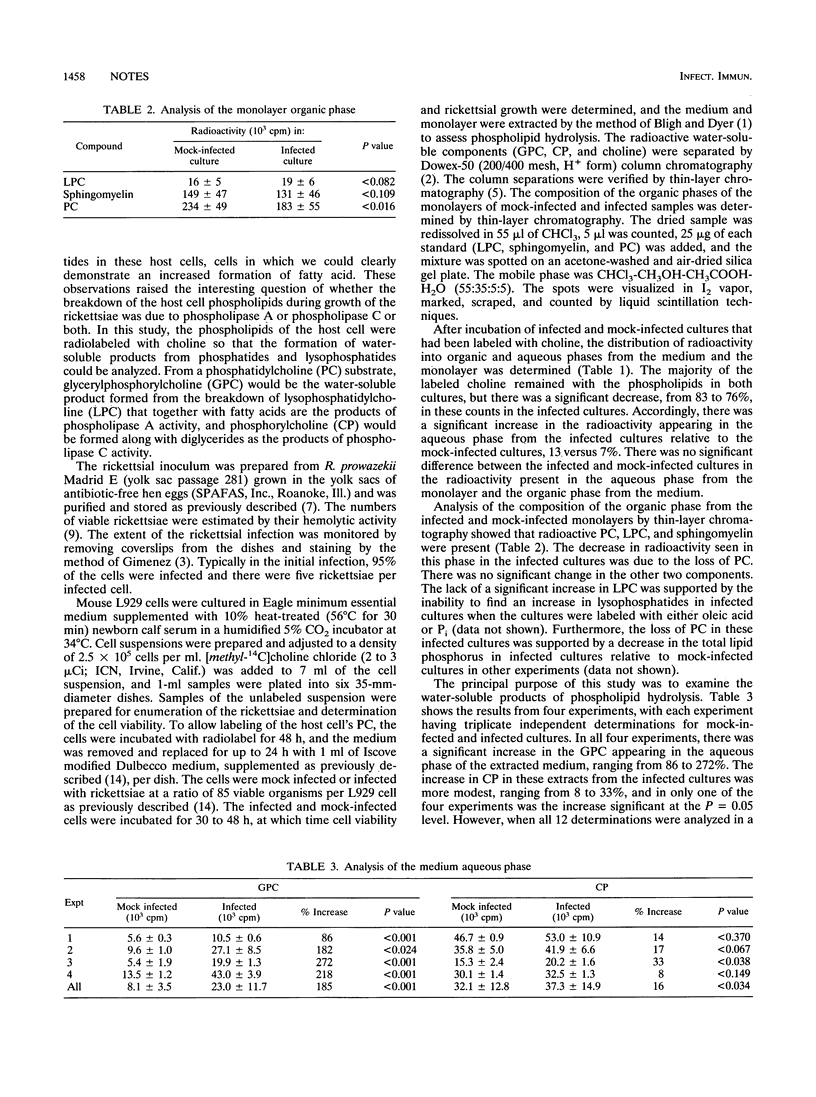Abstract
A phospholipase activity has been associated with the interaction of Rickettsia prowazekii with the surface of erythrocytes and competent host cells as well as during the growth of the rickettsiae within their host cells. Both fatty acid and lysophosphatides have been found in the interaction of rickettsiae with the surface of eucaryotic cells; this finding provided strong evidence for the activity of a phospholipase A. However, fatty acids, but not lysophosphatides, were found during the growth of rickettsiae within cells in which the phospholipids had been radiolabeled with oleic acid; this observation left the type of phospholipase activity in doubt. In this study, the water-soluble components of phospholipid hydrolysis by phospholipase A plus lysophospholipase and phospholipase C were determined following the growth of rickettsiae in host cells in which the phospholipids had been radiolabeled with choline. In infected cells relative to mock-infected cells, there was a loss of phosphatidylcholine with a corresponding increase not in lysophosphatidylcholine but in the water-soluble components. There was a large increase in glycerylphosphorylcholine (185%) and a smaller increase in phosphorylcholine (16%). These results indicate that both phospholipase A activity (plus a lysophospholipase activity) and phospholipase C were increased during infection by R. prowazekii and that the former was the predominant activity.
Full text
PDF


Selected References
These references are in PubMed. This may not be the complete list of references from this article.
- BLIGH E. G., DYER W. J. A rapid method of total lipid extraction and purification. Can J Biochem Physiol. 1959 Aug;37(8):911–917. doi: 10.1139/o59-099. [DOI] [PubMed] [Google Scholar]
- Cook S. J., Wakelam M. J. Analysis of the water-soluble products of phosphatidylcholine breakdown by ion-exchange chromatography. Bombesin and TPA (12-O-tetradecanoylphorbol 13-acetate) stimulate choline generation in Swiss 3T3 cells by a common mechanism. Biochem J. 1989 Oct 15;263(2):581–587. doi: 10.1042/bj2630581. [DOI] [PMC free article] [PubMed] [Google Scholar]
- GIMENEZ D. F. STAINING RICKETTSIAE IN YOLK-SAC CULTURES. Stain Technol. 1964 May;39:135–140. doi: 10.3109/10520296409061219. [DOI] [PubMed] [Google Scholar]
- Martin T. W. Formation of diacylglycerol by a phospholipase D-phosphatidate phosphatase pathway specific for phosphatidylcholine in endothelial cells. Biochim Biophys Acta. 1988 Oct 14;962(3):282–296. doi: 10.1016/0005-2760(88)90258-5. [DOI] [PubMed] [Google Scholar]
- Silverman D. J., Santucci L. A., Meyers N., Sekeyova Z. Penetration of host cells by Rickettsia rickettsii appears to be mediated by a phospholipase of rickettsial origin. Infect Immun. 1992 Jul;60(7):2733–2740. doi: 10.1128/iai.60.7.2733-2740.1992. [DOI] [PMC free article] [PubMed] [Google Scholar]
- Turco J., Winkler H. H. Inhibition of the growth of Rickettsia prowazekii in cultured fibroblasts by lymphokines. J Exp Med. 1983 Mar 1;157(3):974–986. doi: 10.1084/jem.157.3.974. [DOI] [PMC free article] [PubMed] [Google Scholar]
- Walker T. S., Winkler H. H. Penetration of cultured mouse fibroblasts (L cells) by Rickettsia prowazeki. Infect Immun. 1978 Oct;22(1):200–208. doi: 10.1128/iai.22.1.200-208.1978. [DOI] [PMC free article] [PubMed] [Google Scholar]
- Walker T. S., Winkler H. H. Rickettsial hemolysis: rapid method for enumeration of metabolically active typhus rickettsiae. J Clin Microbiol. 1979 May;9(5):645–647. doi: 10.1128/jcm.9.5.645-647.1979. [DOI] [PMC free article] [PubMed] [Google Scholar]
- Weiss E. Growth and physiology of rickettsiae. Bacteriol Rev. 1973 Sep;37(3):259–283. doi: 10.1128/br.37.3.259-283.1973. [DOI] [PMC free article] [PubMed] [Google Scholar]
- Winkler H. H., Daugherty R. M. Phospholipase A activity associated with the growth of Rickettsia prowazekii in L929 cells. Infect Immun. 1989 Jan;57(1):36–40. doi: 10.1128/iai.57.1.36-40.1989. [DOI] [PMC free article] [PubMed] [Google Scholar]
- Winkler H. H., Day L., Daugherty R., Turco J. Effect of gamma interferon on phospholipid hydrolysis and fatty acid incorporation in L929 cells infected with Rickettsia prowazekii. Infect Immun. 1993 Aug;61(8):3412–3415. doi: 10.1128/iai.61.8.3412-3415.1993. [DOI] [PMC free article] [PubMed] [Google Scholar]
- Winkler H. H. Early events in the interaction of the obligate intracytoplasmic parasite, Rickettsia prowazekii, with eucaryotic cells: entry and lysis. Ann Inst Pasteur Microbiol. 1986 May-Jun;137A(3):333–336. doi: 10.1016/s0769-2609(86)80044-8. [DOI] [PubMed] [Google Scholar]
- Winkler H. H., Miller E. T. Phospholipase A activity in the hemolysis of sheep and human erythrocytes by Rickettsia prowazeki. Infect Immun. 1980 Aug;29(2):316–321. doi: 10.1128/iai.29.2.316-321.1980. [DOI] [PMC free article] [PubMed] [Google Scholar]
- Winkler H. H., Miller E. T. Phospholipase A and the interaction of Rickettsia prowazekii and mouse fibroblasts (L-929 cells). Infect Immun. 1982 Oct;38(1):109–113. doi: 10.1128/iai.38.1.109-113.1982. [DOI] [PMC free article] [PubMed] [Google Scholar]
- Winkler H. H. Rickettsia species (as organisms). Annu Rev Microbiol. 1990;44:131–153. doi: 10.1146/annurev.mi.44.100190.001023. [DOI] [PubMed] [Google Scholar]
- Winkler H. H., Turco J. Rickettsia prowazekii and the host cell: entry, growth and control of the parasite. Curr Top Microbiol Immunol. 1988;138:81–107. [PubMed] [Google Scholar]


